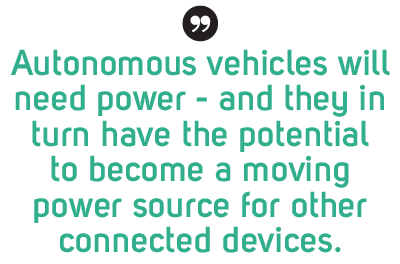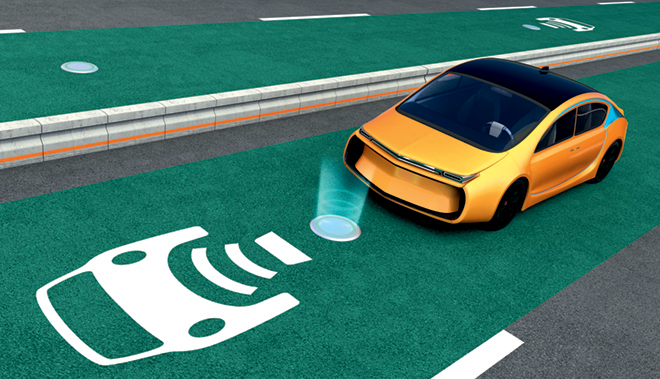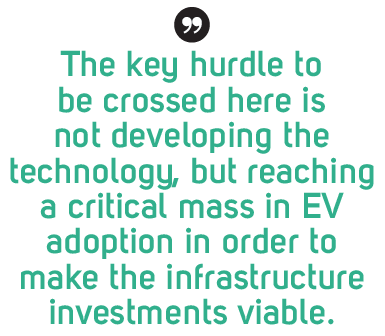By Alex Gruzen, CEO of WiTricity
There’s no question that autonomous electric vehicles are coming. From Google and Uber to Tesla, BMW and Nissan, the world’s most innovative brands are conceiving and bringing to market entirely new modes of transportation that will revolutionize the ways in which we travel. According to Navigant Research, by 2035 the number of autonomous-capable vehicles sold worldwide is expected to reach 85 million annually.
However, the impact of the self-driving car will not only dramatically alter transportation, it will paint an entirely new picture of city living. The infrastructure that cities are built upon will need to be rethought. Autonomous vehicles will need power – and they in turn have the potential to become a moving power source for other connected devices. A fundamental part of the smart city of the future’s ecosystem: wireless power.

The autonomous future: what could be
Autonomous vehicles will offer a new mode of personal transportation to people who do not want to own a car for financial or personal reasons, and will deliver the huge benefit of mobility for people who cannot operate a vehicle – from children to the elderly to the disabled. More individuals will have the opportunity to be mobile and engaged members of their communities. When there is no driver, everybody will be a passenger and have the chance to use driving time to do work and be productive, or just nap and recharge.
The entire vehicle layout could be re-imagined, too. The car of the future could feature inward-facing lounge seats. The vehicle will no longer be just a mode of transportation, but an extension of the home or the office, creating a new environment to engage and add time to the day.
Beyond those benefits, streets will be safer and fewer accidents will occur, as smart technology will allow vehicles to automatically avoid road hazards. Public safety could increase through the elimination of drunk driving. Traffic congestion may decrease as cars will move at the same speed at regularly spaced intervals. Less time will be spent finding parking spots, as cars will be able to drop off their passengers, then go off to park on their own. City centers will waste less valuable real estate on parking lots and garages.

To optimize autonomous travel, add wireless charging
While autonomous vehicles are sure to revolutionize personal transportation, a major question has been largely overlooked: how will these cars be fueled? Consider the irony of having autonomous EVs cart our youth to school, take the injured to their doctor appointments and escort our elderly to the park, only to require some person to plug them in after a trip is complete. There has to be a simpler solution.
The charging process of the future must take people out of the charging equation, just as it takes them out of the driving equation. When a vehicle needs to charge, it will park itself over a wireless charging pad and automatically top up the battery without ever plugging in.
Replacing the power plug is a bold task, and will require wireless technology that can efficiently transfer a vehicle’s full power needs and that is flexible enough to work across a variety of vehicles. Perhaps the most promising technology is magnetic resonance. In fact, many automakers are already marching towards production in upcoming electric vehicles. Magnetic resonance offers a host of benefits, including flexible positioning, high efficiency, and the ability to transfer power through materials like concrete and asphalt. Magnetic resonance technology allows wireless charging pads to be installed on the ground, in the floor of a garage or under the road. Remarkably, the latest designs can move power at the same levels as plugging in and with similar efficiency – there is no penalty for going wireless. Autonomous vehicles will simply park and charge to top off their batteries. Without the need for human intervention to recharge batteries, vehicle transport can become another expected basic service like the internet or the electric grid, and passengers can focus on other concerns, knowing cars will be ready and available when needed.
As the technology matures and volume drives down costs, innovative companies can work with governments and infrastructure developers to create city-wide grids of wireless power sources embedded in streets. These embedded sources will wirelessly trickle-charge vehicles as they drive, allowing unmanned transporters to extend driving range or reduce the size and cost of batteries required to power the vehicles. With lower cost comes increased adoption, and a virtuous cycle is begun.
Moving the future: powering more than
vehicles
Looking ahead even further, wireless charging and autonomous vehicles are a great fit with the concept of vehicle-to-grid (V2G) systems. V2G describes a system in which plug-in vehicles communicate with the power grid to manage bidirectional charging. Charging times can be scheduled to take advantage of the lowest rates, and vehicles can serve as power storage devices. A V2G network could efficiently move power around to where it is needed, at the lowest cost possible.
When combined with self-driving vehicles and wireless charging, V2G could become an automated process. Autonomous vehicles could deliver people to work or to their homes, connect to the power grid wirelessly, and return power to the grid to reduce overall usage. During off-peak hours, these vehicles could guide themselves to wireless charging spots to top off at reduced energy rates. V2G offers a unique solution to leveling out power usage and ensuring that additional capacity is always available, considering that at any given moment a vast majority of vehicles are idle.

The infrastructure to make it reality
Manufacturing and selling autonomous vehicles, and replacing fuel stations with wireless charging infrastructure in garages and ultimately in roads, certainly won’t happen overnight. We can expect these changes to occur over the coming decade, starting with plug-in hybrid and pure electric vehicles charging through wireless transmitter pads in their owners’ garages. From there, we can expect transmitter pads in office and mall parking lots before we will see them embedded in the roadways. Finally, once the infrastructure is embedded in the roadways, vehicles will be able to power-snack, store energy, and deliver it back to the grid. The key hurdle to be crossed here is not developing the technology, but reaching a critical mass in EV adoption, in order to make the infrastructure investments viable. For example, strong government intervention in favor of EVs in major Chinese cities, in part to reduce pollution, may in fact be setting the stage for this vision sooner than we would otherwise expect.
However, in order for this vision to become reality, interoperability will be critical. The wireless charging industry must agree on an interoperability standard so that vehicles and charging infrastructure can communicate with each other, ensuring a convenient user experience. The Society for Automotive Engineers (SAE) and other standards bodies are leading this effort to establish performance and safety criteria for the wireless charging of plug-in vehicles.
Already, some of the leading automotive brands, such as Toyota, BMW, Mercedes, Honda and Nissan, have announced plans to embed magnetic resonance charging into the vehicles they are creating. Tier 1 suppliers such as Delphi, TDK, IHI and Brusa are ramping up their capability to supply automakers with full solutions. As more follow suit and the SAE consolidates standards for magnetic resonance wireless charging, we’ll have the building blocks in place for the smart city evolution.
The new normal
Can the availability of wirelessly-charged autonomous EVs truly become an expected service in our cities, effectively becoming the new normal? The answer is yes. Just look at the phones in our homes, for example. While the Baby Boomer generation may still refer to them as “cordless phones,” Millennials simply call them “phones,” never having known cords in their lifetimes.
Recently, in the city of Austin, Texas, a referendum on driver fingerprint background checks resulted in both Uber and Lyft ceasing operations. It was remarkable to see how in just a couple of years the population had come to expect the availability of ride-hailing services, and how ill-prepared residents, visitors, and local businesses were for the sudden disappearance of this option for mobility. The city population had established new habits and embraced shared mobility faster than any of us could ever have imagined. In place of Uber and Lyft, Austin residents were quick to embrace alternatives such as Arcade City/Request a Ride – a Facebook group that enables users to find rides to and from their destinations – and new ride-hailing apps like getme, Fare and Fasten.
With this perspective, it’s clear that the availability of autonomous electric vehicles will quickly become an expected service in cities, providing convenience, public safety and productivity, while dramatically improving the environment. The rapid advances in magnetic resonance wireless charging will play an exciting role in enabling this “new normal.”
This article originally appeared in Charged Issue 26 – July/August 2016. – Subscribe now.









































































































